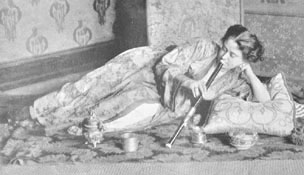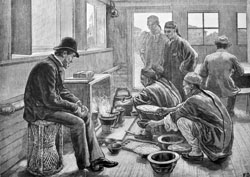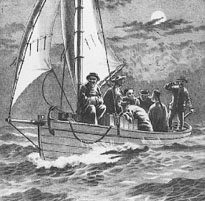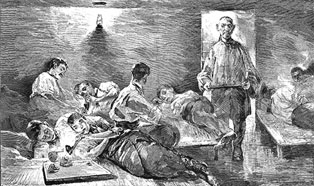OPIUM 3
a. Victoria: the largest opium making center outside Asia 域埠- 欧美鴉片烟总汇 [updated 08/22/12]
a1. Canada's other opium makers: Vancouver, New Westminster, Nanaimo [posted 01/09/11]
b. Refining and packaging opium for sale [posted 8/9/09]
c. Opium brand names 鴉片烟牌子 [updated 11/16/09]
d. More opium brand names: from gold mining sites in the Cariboo [updated 01/18/10]
d1 Even more opium brand names, from Idaho's AACC [posted 3/3/11]
d2 Opium cans from Australia [posted 2/6/12]
d3 More opium brands from Australia: the Hong Kong-North American connection [posted 2/23/12]
d4 Even more, this time from Victoria in the South, not Queensland in the North [posted 3/6/2015]
d5 The best-dated opium brands: from railroad camps in Montana [posted 3/6/12]
f Opium cans or "tins" 鴉片烟罐 [posted 8/14/09]
g. Opium cans of the prohibited period 1909年禁烟以后的洋烟罐 [updated 1/17/11]
g1 Kwangchow-Wan brands and the French connection [posted 1/17/11, updated 3/26/13]
g2 Opium smuggling and Lam Kee's opium factory in Macao [posted 3/26/13]
h. Fake opium brands in San Francisco 三藩市冒牌鴉片烟 [posted 9/6/09]
h1 Counterfeiting Hong Kong opium [posted 9/15/12]
h2 Paper Labels on Opium Cans [posted 4/18/11]
i.. Commercial trickery in Canadian opium labeling [posted 12/28/10]
j.. Opium Retailers in San Francisco, 1900-1904 三藩市鴉片烟华商 [posted 12/17/09]
k.. Triumph of 19th century chemistry: making Middle Eastern opium smokable 土耳其鴉片 [12/29/09]
l.. Direct evidence of a Middle East/Balkans to Pacific Northwest connection [posted 12/29/09]
m. A public-spirited narcotics cartel? The modest profits of Victoria's opium refiners [posted 08/21/12]
n. Chinese sources for opium market prices in the U.S [posted 11/29/16]
b. A governor-general and his wife visit a Victoria opium "factory" in 1895 [posted 11/10/09]
c. Smuggling incidents and tales 個案 [updated 8/14/09]
d. More smuggling incidents and tales The Great Smuggling Ring, 1893 [posted 12/15/09]
d1. "A prepossessing young widow" from Port Angeles [posted 01/24/12]
e. "The pretty smuggler and her pathetic story" [posted 11/1/09]
f.. A fashionable young lady gets caught with a half-ton of opium [updated 12/17/09]
g. Diving for opium in Puget Sound: a true story 打捞 [updated 10/1/09]
a. Opium equipment in the U.S., 1896 煙具 [posted 8/1/09]
b. How opium pipes worked [posted 10/8/09]
c. Opium pipe bowls show Chinese immigrants' middle-class aspirations [posted 10/8/09]
e. Brand dominance in the opium pipe bowl trade [posted 10/27/09]
e1 Pipe bowl brands found in both America and Australia [posted 2/23/12]
f. North American opium lamps [posted 11/3/09]
g. Commerce in opium lamp chimneys 烟灯灯罩广告[posted 12/1/09]
i. How much opium did white Americans use? The Iowa case [posted 12/19/09]
i-1. Marketing opium to white-Americans before 1914 [posted 7/15/2012]
j. The opium addicts of Albany, NY [posted 12/21/09]
k. Opium suicides [posted 12/17/10]
b. Addiction Cures for North American Chinese [posted 10/15/09]
c. Curing addicts and outlawing the opium trade: the missionary connection [posted 10/19/09]
d. British Columbia defends Britain against Opium War slander [posted12/28/09]
e. The Addict's Progress: anti-opium propaganda in China, 1883 [posted 04/21/11]
a. Lurid pictures of opium dens [posted 05/30/10, updated 04/18/11]
b. Exaggerating harm from opium use [posted 05/30/10]
Making & Selling
Smuggling
Using
Banning & Curing
Thia page was added in November 2017 due to lack of space on the other two opium pages. Future articles on Chinese opium in North America will appear here
版权 Copyright is free for non-profit use: : click here for more information
This page was last updated: August 15, 2019
Chinese Sources for Opium Market Prices in the U.S.
Sources: Our information comes from issues of several Chinese-language newspapers published in San Francisco: <1> San Francisco Chinese News 旧金山唐人新闻 (1875); <2> The Orientals (Tangfan gongbao唐番公报)(1876); <3> The Oriental Chinese Newspaper (Huayang Huaji Xinbao華洋華记新报)(1887); >4> The American Chinese Commercial (Huamei Xinbao, Suiji 華美新報-萃记)(1894); <5> Chung Sai Yat Po 中西日报 (1900-1910). Of these, Chung Sai Yat Po is available in several libraries. The others are hard to get.
Note: the links in this table of contents are not yet functional. To find the following articles, go to Opium or Opium-2 and click on the links there.
The "Smoking Opium Exclusion Act" of 1909. What did it actually prohibit?
The 1909 bill reads as follows. Iit should be noted that the bill's title was not, as sometimes stated,“The Smoking Opium Exclusion Act.” It may have been intended to have that effect, but on the surface it was an act to prohibit the importation of all opium, whether or not prepared for smoking, unless for use as medicine.
SIXTIETH CONGRESS, February 9, 1909
HR 27427. Act to prohibit the importation and use of opium for other than medicinal purposes.
Be it enacted by the Senate and House of Representatives of the United States of America in Congress assembled, That after the first day of April, nineteen hundred and nine, it shall be unlawful to import into the United States opium in any form or any preparation or derivative thereof: Provided, that opium and preparations and derivatives thereof, other than smoking opium or opium prepared for smoking, may be imported for medicinal purposes only, under regulations which the Secretary of the Treasury is hereby authorized to prescribe, and when so imported shall be subject to the duties which are now or may hereafter be imposed by law
.
Sec. 2. That if any person shall fraudulently or knowingly import or bring into the United States, or assist in so doing, any opium or any preparation or derivative thereof contrary to law, or shall receive, conceal, buy, sell, or in any manner facilitate the transportation, concealment, or sale of- such opium or preparation or derivative thereof after importation, knowing the same to have been imported contrary to law, such opium or preparation or derivative thereof shall be forfeited and shall be destroyed, and the offender shall be fined in any sum not exceeding five thousand dollars nor less than fifty dollars, or by imprisonment for any time not exceeding two years, or both. Whenever, on trial for a violation of this section, the defendant is shown to have, or to have had, possession of such opium or preparation or derivative thereof, such possession shall be deemed sufficient evidence to authorize conviction unless the defendant shall explain the possession to the satisfaction of the jury.
Approved, February 9, 1909
As the drafters of the 1913 bill pointed out, the 1909 version had almost no effect on the booming trade in Middle Eastern opium for drinking and eating, or on trade in injectable drugs like morphine and heroin, All became legal as soon as a doctor affirmed they were medical. Because the law explicitly banned opium prepared for smoking, the 1909 drafters seem to have been aiming mainly at Chinese. And it was still legal to possess and use smoking opium, just as long as it had been imported before April 1, 1909. The problem was that newly smuggled-in opium was often repackaged in old pre-a909 cans.






